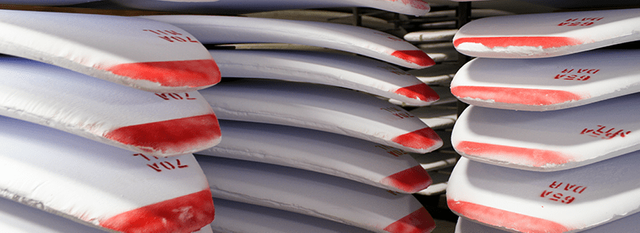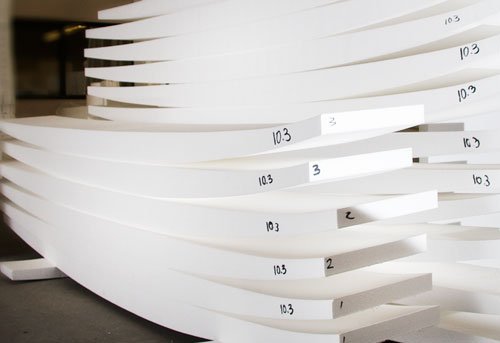Once you have decided on what type of surfboard you want to create, you'll then have to get your hands on a blank.
There are two types of foam these blanks are made of:
- Polyurethane (PU)
- Expanded Polystyrene (EPS)
Polyurethane
Easy to shape. Smooth, heavier, and compatible with polyester or epoxy resin. This is the most common route.

Expanded Polystyrene (Styrofoam)
Difficult to shape. It will flake off in chunks if tools are not used properly, requires filler/spackling before glassing, lighter, needs epoxy resin, can be made from recyclable materials. More and more boards are going this route.

What we've been doing is using PU blanks since we consider ourselves beginners, and we recommend you do the same. The EPS is more difficult to work with. EPS material sticks to your tools and clothing, and it requires a filler coat before you glass just adding another step to the process. Eventually we will get to an EPS board.
Securing your blank is as simple as visiting US Blanks and selecting the blank based on the dimensions of the board you want. There are other factors to consider, such as foam density, stringer, rocker adjustments, etc. YET as a beginner the only thing you really need to concern yourself with is the blank's overall dimensions.
The length of the blank should ideally be 1″-3″ longer than your outline, and the width/thickness should be at least 1/4″ more than the final shape. Blanks generally have 1/8" of thick outer crust that you'll need to remove.
It’s also important to note that a standard blank’s width and thickness are measured from the center of the blank. If your desired shape’s wide point is front or back of center, you need to keep in mind the variance as you move up and down from the board's center.
While you ought to mainly concern yourself with blank dimensions, many shapers agree that rocker is just as important a consideration. Blank manufacturers will provide a rocker description for each blank. We recommend you read this and think about the purpose of your board. Generally speaking, you want more rocker for larger waves and less rocker for smaller ones.

Hope this helps guide you through your board building process. Get out there and have some fun!
More Resources:
http://www.surfscience.com/topics/surfboard-anatomy/materials/know-your-foam/
http://foamez.blogspot.com/2017_03_05_archive.html
Congratulations @maven360! You have completed some achievement on Steemit and have been rewarded with new badge(s) :
Click on any badge to view your own Board of Honor on SteemitBoard.
For more information about SteemitBoard, click here
If you no longer want to receive notifications, reply to this comment with the word
STOPDownvoting a post can decrease pending rewards and make it less visible. Common reasons:
Submit
Congratulations @maven360! You have completed some achievement on Steemit and have been rewarded with new badge(s) :
Click on any badge to view your own Board of Honor on SteemitBoard.
For more information about SteemitBoard, click here
If you no longer want to receive notifications, reply to this comment with the word
STOPDownvoting a post can decrease pending rewards and make it less visible. Common reasons:
Submit